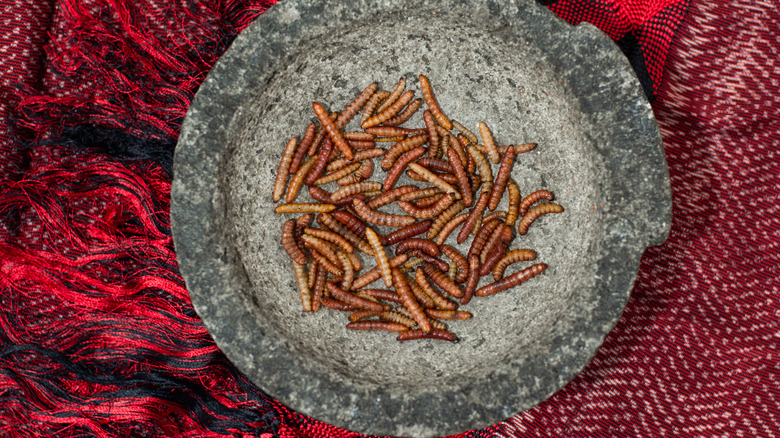Umami Sal De Gusano Belongs On Your Fresh Fruit Slices
Many cultures around the world consume insects, but Mexico leads with the variety on offer. From delicious tangy chapulines to nuanced, delicately-flavored ant eggs called escamoles, there are many options to choose from. For a delicious foray without any insect semblance, start with sal de gusano. Made with red maguey worms and salt, you're most likely to encounter this seasoning on top of an orange slice at a mezcal bar.
Combining earthy flavors with spice, some smokiness, and an element of savoriness, it's a wondrously complex flavor. Its umami-laden taste, accentuated by a satisfying puckering of the lips, makes it the perfect accompaniment to some cut-up fresh fruit. However, it can also add depth to guacamole, salsa, enchiladas, ceviche, and a range of other applications. Who knew that such incredible flavors could all arise from a small worm? As time has told, it makes a surprisingly unconventional useful seasoning to have on hand.
What is sal de gusano?
Agave larvae have been consumed by Aztecs, Mayans, and other civilizations in Meso-America for centuries. Especially valued by Aztecs, the food is still occasionally referred to by its traditional name — Chinicuil. The agave worms were believed to have medicinal qualities that, when consumed, could also make one stronger. They were also associated with those of higher social class. While their popularity took a dip after the Spanish arrival, the salt is now experiencing a revitalization. The practice of grinding the worms with salt continues to be prevalent in regions across Mexico, with many variations in the recipe and processing method.
Sal de gusano is prepared by first harvesting the larvae from the agave plant. These small caterpillars, which are a reddish color, nestle in the plant during the rainy season, and their collection aids maguey growth. Next, they're air-dried in the sun or toasted in a comal. To finish, the maguey worms are ground alongside salt, dried chilies, and additional regional flavorings like zests or spices.
How to use sal de gusano
As a substance derived from the agave plant, the salt frequently accompanies a shot of mezcal. At agave bars, it's usually sprinkled onto fruit, which is most frequently an orange slice, but sometimes pineapple and is eaten after sipping. Rather than being a chaser, it's meant as an umami complement to the spirit, and some bartenders also utilize it as a salty rim for a cocktail.
Sal de gusano makes for a delectable food even without the boozy companion. It's delicious sprinkled on grilled vegetables such as zucchini, and it can add depth to salsas or soups. Add some when slow-cooking meat for tacos, or sprinkle the salt on top of a batch of enchiladas. With its earthy flavor, the salt also pairs well with avocado for guacamole. And it is particularly delicious with bright acidic flavors — there's a reason it's enjoyed on limes and oranges. Once a jar is purchased, there's always a reason to sprinkle more.
Where to buy sal de gusano
In Mexico, the salt is widely available in markets, especially in Oaxaca. With its popularity alongside mezcal, it can also be found in liquor stores, even in the U.S. However, it's easiest to buy sal de gusano online via Amazon and other retailers. Some of these include Bitterman Salt Co., Gran Mitla, or Compania de Sales, each with their unique recipe and flavor palate. Purchase based on the intended use since some salts run spicier for cooking, while others are smokier for the perfect drink accompaniment. Once procured, the compound is very self-stable. In dry, dark conditions, it will keep for up to one year.
To craft a personalized sal de gusano flavor, it's possible to craft the salt at home, too. If a purchased bottle of mezcal has the worm floating in the liquor, retrieve it and dry the larva. Combine with a teaspoon of salt and other flavorings such as chocolate or chile in a mortar and pestle. And voilà, an umami-laden sal de gusano is born.



